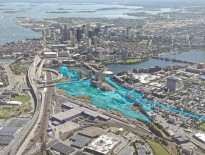It’s not a bad time to look back at the biggest life sciences development projects of the past five years, even as we forecast how impending projects will continue to change the physical landscape of the industry.
The sheer size of the Novartis project at 181 Massachusetts Ave. in Cambridge impresses. At over 550,000 square feet in three buildings, the new Novartis campus, across from its existing Mass. Ave. operations, is mammoth even amidst its many life sciences neighbors. It even tries to look a bit different, with a Maya Linn-inspired design resulting in a Mass. Ave. façade that one will either love or hate. Together with its neighbor development at 610 Main St., at which Pfizer is the anchor tenant, the Novartis campus has radically transformed the four square city blocks upon which it sits.
On the other side of Technology Square, another reaffirmation of Kendall Square as the premier global hub of biotech was completed. In 2008, Biogen moved its corporate headquarters from Cambridge to suburban Weston. When George Scangos succeeded Jim Mullen as Biogen CEO, however, the preference to reunite the corporate with research minds of Biogen at one place became evident. By 2014, in a dramatic about-face, Biogen had moved its headquarters back to Cambridge to a new building at 225 Binney St., just down the road from its other new construction at 17 Cambridge Center. With 497,000 square feet in new space in Cambridge, Biogen had clicked its heels and resoundingly confirmed “there’s no place like home.”
As sensational as Biogen’s return to Cambridge was, so was Vertex Pharmaceutical’s departure for Boston. Vertex had grown where space allowed in Cambridge since its founding in 1989. Long in the hunt for new space to consolidate operations, Vertex also seemed to want a prominent spot away from its Cambridge peer companies – but not too far away. After a prior abortive attempt, the real estate fortunes aligned for developer Joe Fallon and the landmark Vertex facility at Fan Pier advanced to completion in 2014. While the 1.1-million-square-foot, $800-million, two-building project has not heralded an exodus of other large life science companies from Cambridge to Boston, it has created the largest presence of a major company south of the Charles.
Suburban projects also rattled some cages over the past five years. In 2011, EMD Serono opened a 140,000 square foot research facility in Billerica. Established as one of its global research “hubs,” EMD’s Billerica investment was in the vanguard of other significant life science facility moves to what is biotech’s “hot corner” in the northwest suburbs. The relocation of Shire’s U.S. headquarters from Pennsylvania to its Lexington campus is a recent illustration of the area’s partial counterweight to Kendall Square.
Looking ahead, it’s hard to imagine projects that portend greater impact on the physical development of the industry than the MIT’s Kendall Square Initiative and the prospective redevelopment of the U.S. Department of Transportation’s Volpe Center campus nearby. Just when there didn’t seem to be any more space in Kendall Square, these two projects may take wing over the next five years.
MIT’s Kendall Square Initiative, now advancing through the local approvals process, would comprise six new buildings north and south of Main Street. It would include close to 600 units of community and student housing, 100,000 square feet of retail and over 800,000 square feet of research and office space. It would be a transformative project, adding needed retail assets while creating an urban downtown neighborhood that East Cambridge has only haltingly advanced toward to date.
Just two blocks away, the federal government plans a first-of-its-kind redevelopment of the Volpe Center, conveying some part of its 14-acre site to a private developer while leveraging a new, state-of-the art-research facility for itself. For decades, developers have longed for a shot at the Volpe Center. In 2016, one developer will emerge with a project for the ages.
“All glory is fleeting,” is the message heard by a reflective General Patton, as played by George C. Scott, just before the closing credits roll in the 1970 movie classic, “Patton.” As true as the statement is, it is now hard to imagine when the glory will wane with respect to the physical expansion of the life sciences in Massachusetts. n
Peter Abair is executive director of the MassBioEd Foundation.







